Post by stinkiesdaddy on Feb 14, 2010 14:03:04 GMT -6
Basic maintenance of spinning reels.
The following are some basic maintenance procedures that I perform on my spinning reels. How often you break down your reels will depend on how often you use them and how much abuse they take with each outing as well as how finicky you are about performance. Keep in mind that this is not meant to be an authoritative manual on reel maintenance. While spinning reels operate on the same basic principles, each manufacturer/model may be different than what is found on my particular Daiwas.
One: Layout
It's important to have a clean and well-lit work area. The ideal would be a dedicated work bench but having none, I use my kitchen island. The white tile gives a nice contrast to those little tiny parts found on fishing reels. Also avoid working on carpeted areas for the same obvious reasons.
Two: What you Need

I lay out all of the things that I am likely going to need BEFORE I get started. These include but are not limited to:
1) set of screwdrivers (both slot and philips heads)
2) pliers
3) knife
4) Corrosion X (metal protectant/light lubricant)
5) grease (Cals for gears/drags and Daiwa Blue for medium lube)
6) reel oil (Rocket Fuel for bearings)
7) white gas/Coleman Fuel (degreasing and cleaning)
8) toothbrush and Q-Tips (cleaning)
9) clean rag
10) small plastic container with lid
11) reel schematic diagram
12) small ziploc bags
It's important to note the specific use of each lubricant. Three or more types may seem like overkill but each performs a specific job and they don't work well outside of the scope of their intended use. Grease is a paste lubricant and essential for main gears. Anything lighter will eventually drip off and provide no lubrication. On the other end of the weight spectrum is reel oil. This is very low viscosity stuff and is meant to seep within the seals of bearings. Corrosion X is a general lubricant that has the great benefit of protecting metals against corrosion. I use Corrosion X on all metal parts outside of the reel and some internal parts that I feel may experience salt intrusion. Since I rip my reels apart on a regular basis, I don't feel a need to coat everything in Corrosion X.
Three: Cleaning the Drags
Most spinning reels have drags located in the center of their spool. The drag elements are accessed by unscrewing the spool knob off completely. The drag washers are usually held in place with a type spring clip (hexagonal). You can remove the clip using a fingernail. If you decide to use a screwdriver, take care that the spring doesn't go flying!
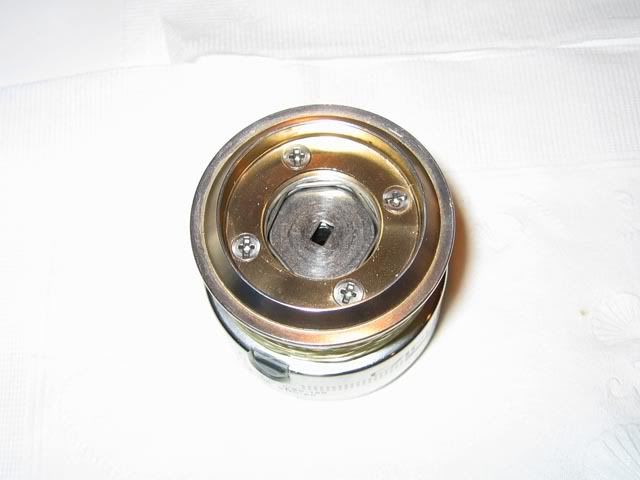
As a rule, smaller spinning reels have simple two-element drag systems while larger reels may have multi-element systems. My Daiwa Capricorn 2000 (top) has one black fiber washer and one metal washer. In contrast, my Capricorn 2500 (bottom) has three fiber washers and three metal washers in alternating order.
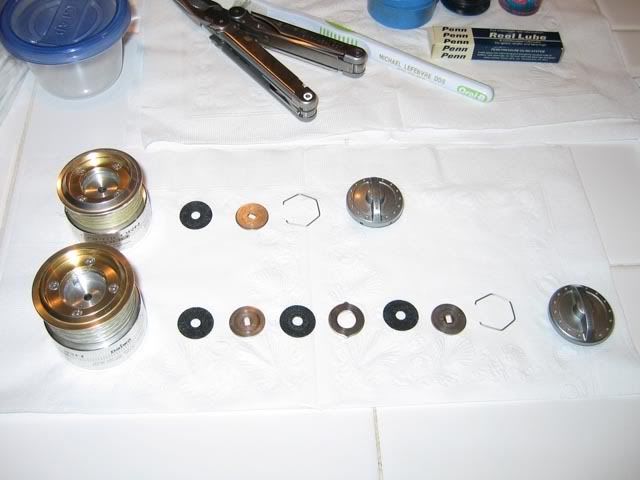
Note that the middle metal washer of the 2500 has ears. It's a good practice to place your disassembled parts in the order that they are removed. This is especially true of drag washers. Get the order wrong and your drags may not function to their full potential. Clean the area of the spool where the washers reside with a damp clothl. Wipe the metal washers and dab the fiber washers dry. If you are using your drags dry, let them air dry completely before reassembly. If they are in need of cleaning, you can soak the washers in white gas to degrease them before drying. White gas may have an adverse affect on some fibrous materials so please be cautious.
If you like wet drags, you can re-grease them (Cal's grease is great for drags) after cleaning and drying. I just dab a small amount of grease on my forefinger, rub the grease on my finger and thumb and then bad the fiber washers with my fingers. Reinstall the washers in the proper order and reapply the spring clip carefully. Make sure the clip is seated properly. Give the spool a shake, the metal drag washers should be prevented from falling out of the spool but move freely enough to clink around in their enclosure.
Rear drags are more complicated but due to my lack of expertise, I can't elaborate.
Four: Cleaning the Line Roller
One of the most critical elements of a spinning reel is the line roller. Due to its external location out there on the rotor, it can get gummed up pretty easily. A dirty roller can cause line twist and a rough retrieve. An inoperative roller can cause line fray and breakage. Fortunately, it's pretty easy to clean. Just remove the screw that holds the roller between the bail and the bail spring mechanism. The screw also acts as the roller axle. The parts of the roller on a Daiwa Capricorn are (from left to right): tiny metal washer, line roller, liner roller bearing and another tiny metal washer.

Many budget spinning reels lack a line roller bearing and feature a metal or plastic bushing instead. Since the washers are so small they may be stuck to other parts due to lubricant. Make sure these aren't lost as they are very important to the smooth operation of the line roller. Take note of which way the roller is on before you take it off. Most newer reels have some sort of twist-buster feature built into the roller and the proper function of this feature will be dependent upon correct orientation. Refer to the schematic as necessary.
Dump all of the parts into a small container of white gas, stir and let sit for a while. This will clean and degrease everything. Clean the area of the bail in which the roller resides using a clean cloth or Q-tip, making sure that it is free of any sand particles. Be very thorough as only a small amount of particulates in the roller can make a reel feel rough under retrieve.
You can put the bearing on a small toothpick and check its rotation. Put a drop of reel oil on the bearing and on all of the other parts and reassemble. Check to make sure the roller spins freely.
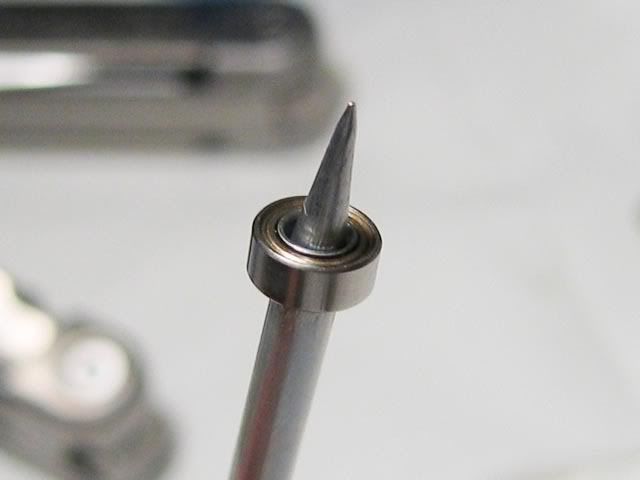
Five: Bail and Bail Spring Assembly
The bail itself is very simple to remove. Once the line roller is disassemble, only one screw is left holding the bail. Unscrew to remove the bail completely.

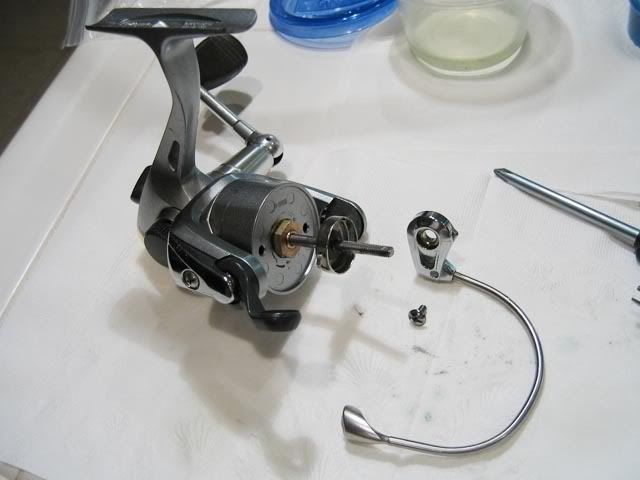
Important: although I've shown the complete removal of the bail, I recommend that you work in subassemblies. In other words, after taking the line roller apart and cleaning it, put it back together before taking off the other end of the bail. This is always a safe strategy. The less loose parts you have at any one time means you have fewer parts to lose and fewer reassembly steps to forget.
My reel was in pretty good shape prior to disassembly. But you can tell from the picture below that there is still some sand that got its way into the bail attachment point. Clean this area thoroughly and lube with a general lubricant like Daiwa Blue Grease before reassembling.
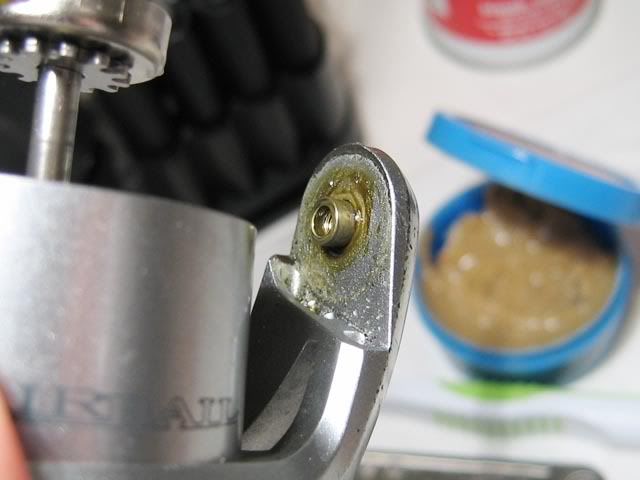
The bail spring assembly is located on the same side of the bail as the line roller. Usually there is some sort of cover that protects the spring assembly from the elements. Below is the reel with the bail spring cover removed but the spring assembly still in place.

This area is a real sand collector on my reels. The cover on my reel is chrome plastic. So instead of using white gas which may mar or distort the plastic, I simply rinse this part off in running water.
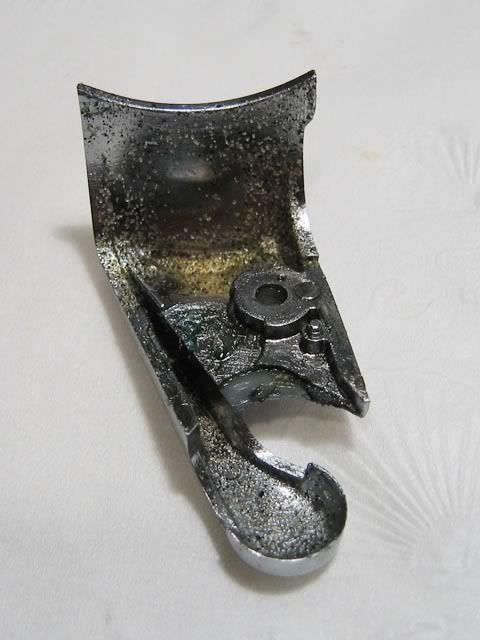
If you move the bail back and forth with the bail spring cover removed, you can see how the bail spring mechanism works.
Bail fully closed:
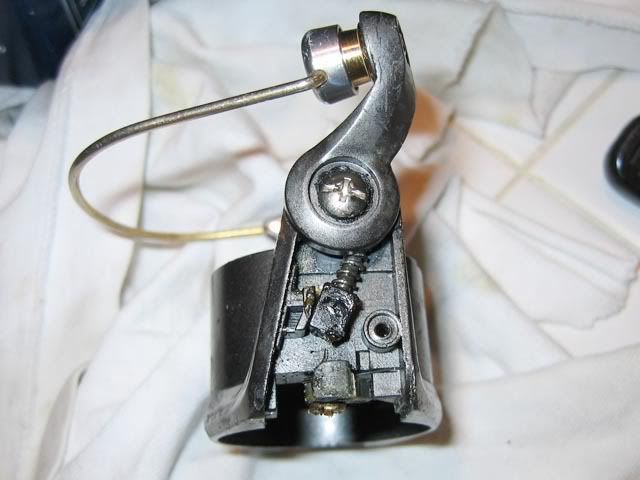
Bail partly open:

Bail completely open:
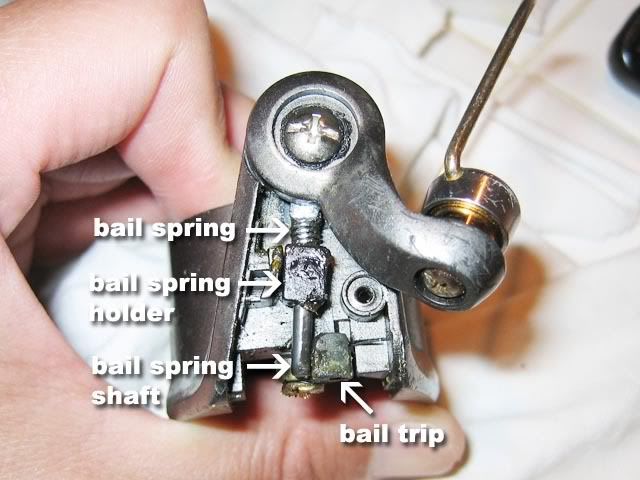
Notice in the above pic how the fully compressed bail spring shaft interacts with the bail trip.
Now detach the bail arm. This assembly is spring-loaded so be careful. The bail spring assembly should be in the position shown below. Notice the orientation of the pin.
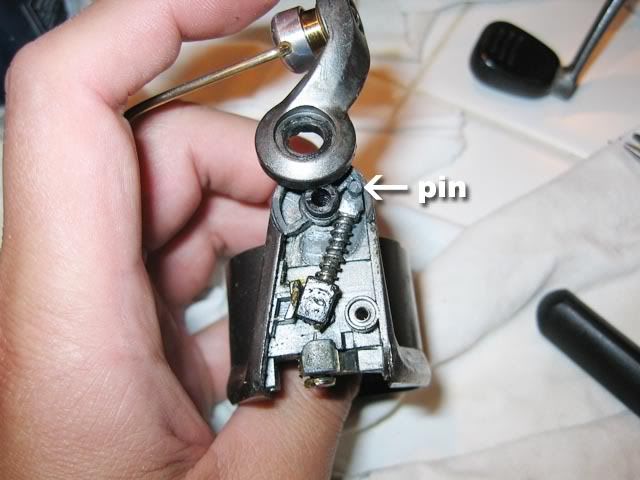
This pin fits into a hole in the base of the bail arm attachment.
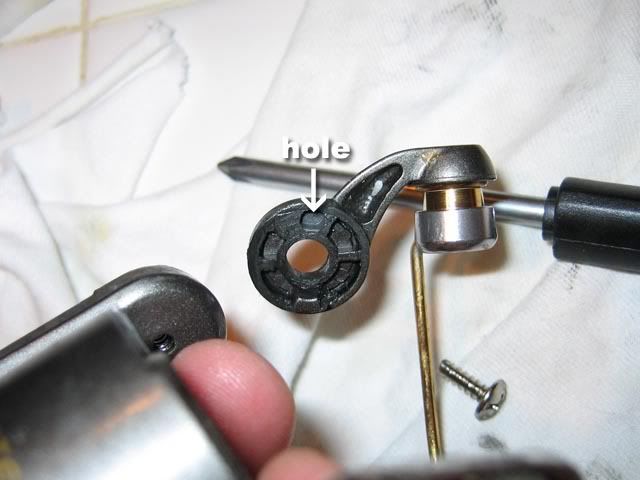
The spring assembly itself is dumped into the white gas to clean. This is the only way to completely remove sand that is imbedded in grease. Once the parts are cleaned and dry, they are regreased and reassembled. For proper reassembly, the pin must fit in the hole so you may have to compress the bail shaft spring slightly to accomplish this. Your reel should now have a smoothly functioning bail and line roller.
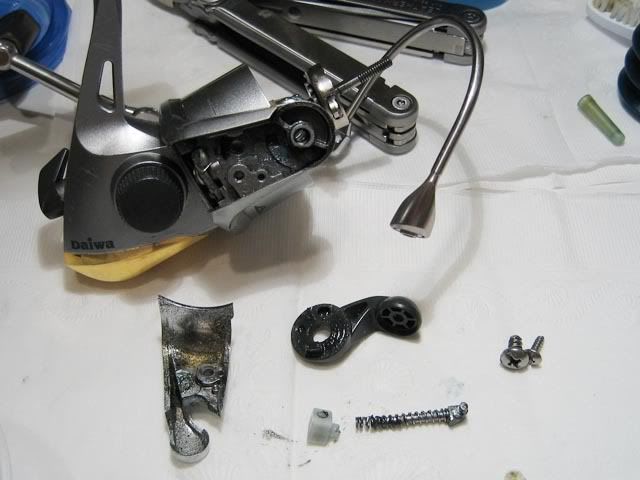
Six: Bail Trip Assembly
Note: The following has only been verified for Daiwa spinning reels (Capricorn & Samurai). Other manufacturers/models may differ. Please refer to your reel's schematic BEFORE messing with this assembly.
For more advanced reel-tweakers, let's revisit the bail trip assembly. On the a simple reel such as a Daiwa Samurai, it can be as simple as two components: the bail trip lever and the bail trip spring. There may also be a washer or two in the mix. Make a note of the order of each piece as you disassemble. Note the orientation of both ends of the spring, in relation to each other and in relation to the lever. The spring is compressed in the pic below.
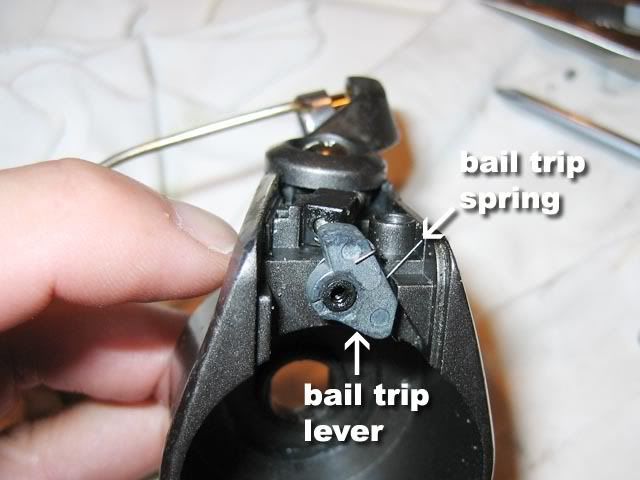
Remove and clean as necessary. The picture below shows how the bail trip spring and bail trip lever are oriented to each other prior to reassembly.
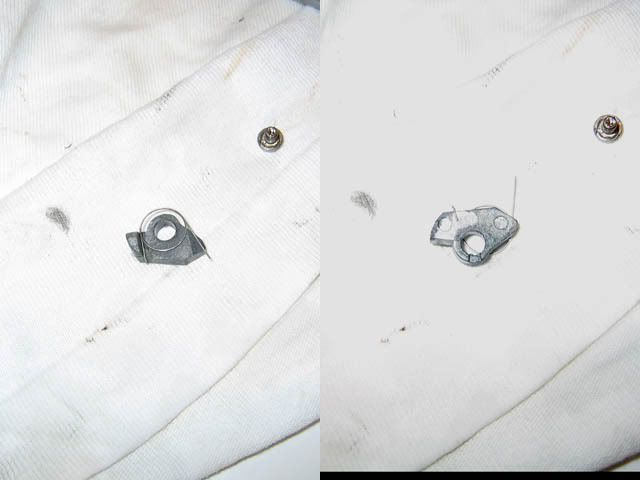
Reassembly can be a little tricky. One good way is to hold the spring and lever together and place them partially on the shaft as shown below.

Gently guide the straight end of the spring into position. Rotate the lever clockwise, seat the lever fully and screw it back on.
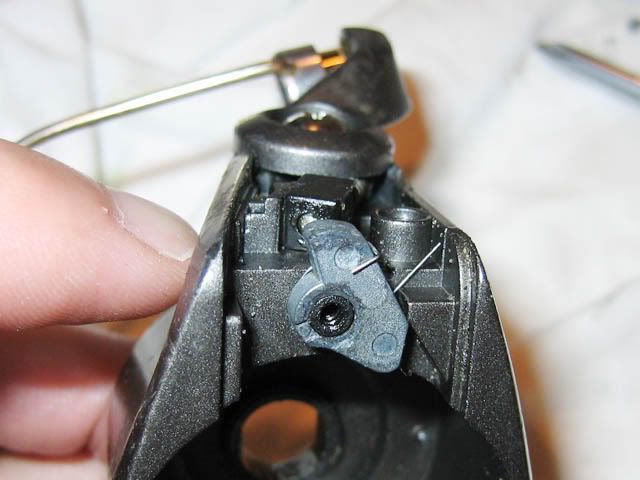
Seven: Other Tips
Another really quick maintenance fix that is commonly overlooked is the handle. A quick shot of lubricant such as Corrosion-X between the plastic paddle and shaft it rotates on will do wonders in restoring the smoothness of your reel. If the paddle shaft is really gunked up, dip the paddle in white gas and stir. Remove, let dry and relubricate using Corrosion-X.
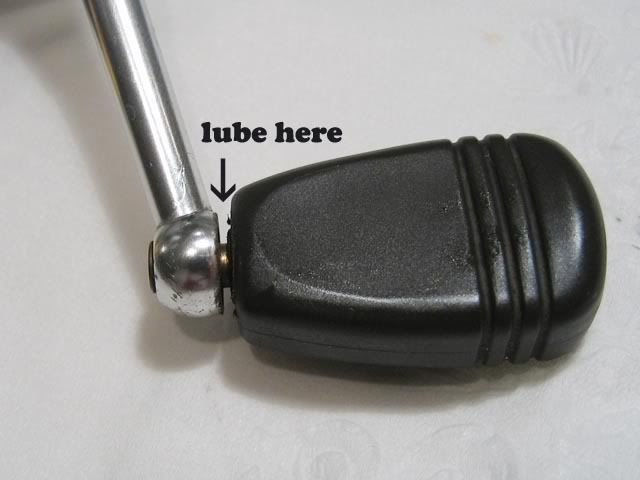
The above maintenance procedures should cover a reel that has not been dumped in the ocean and has been rinsed with fresh water after each saltwater use. If you still have a rough-shod reel after performing the above steps, you may have to remove the rotor and/or crack the body and have a look at the main gears. We'll save that for next time!
Article written by:
John Kim (aka JKim)
The following are some basic maintenance procedures that I perform on my spinning reels. How often you break down your reels will depend on how often you use them and how much abuse they take with each outing as well as how finicky you are about performance. Keep in mind that this is not meant to be an authoritative manual on reel maintenance. While spinning reels operate on the same basic principles, each manufacturer/model may be different than what is found on my particular Daiwas.
One: Layout
It's important to have a clean and well-lit work area. The ideal would be a dedicated work bench but having none, I use my kitchen island. The white tile gives a nice contrast to those little tiny parts found on fishing reels. Also avoid working on carpeted areas for the same obvious reasons.
Two: What you Need

I lay out all of the things that I am likely going to need BEFORE I get started. These include but are not limited to:
1) set of screwdrivers (both slot and philips heads)
2) pliers
3) knife
4) Corrosion X (metal protectant/light lubricant)
5) grease (Cals for gears/drags and Daiwa Blue for medium lube)
6) reel oil (Rocket Fuel for bearings)
7) white gas/Coleman Fuel (degreasing and cleaning)
8) toothbrush and Q-Tips (cleaning)
9) clean rag
10) small plastic container with lid
11) reel schematic diagram
12) small ziploc bags
It's important to note the specific use of each lubricant. Three or more types may seem like overkill but each performs a specific job and they don't work well outside of the scope of their intended use. Grease is a paste lubricant and essential for main gears. Anything lighter will eventually drip off and provide no lubrication. On the other end of the weight spectrum is reel oil. This is very low viscosity stuff and is meant to seep within the seals of bearings. Corrosion X is a general lubricant that has the great benefit of protecting metals against corrosion. I use Corrosion X on all metal parts outside of the reel and some internal parts that I feel may experience salt intrusion. Since I rip my reels apart on a regular basis, I don't feel a need to coat everything in Corrosion X.
Three: Cleaning the Drags
Most spinning reels have drags located in the center of their spool. The drag elements are accessed by unscrewing the spool knob off completely. The drag washers are usually held in place with a type spring clip (hexagonal). You can remove the clip using a fingernail. If you decide to use a screwdriver, take care that the spring doesn't go flying!

As a rule, smaller spinning reels have simple two-element drag systems while larger reels may have multi-element systems. My Daiwa Capricorn 2000 (top) has one black fiber washer and one metal washer. In contrast, my Capricorn 2500 (bottom) has three fiber washers and three metal washers in alternating order.

Note that the middle metal washer of the 2500 has ears. It's a good practice to place your disassembled parts in the order that they are removed. This is especially true of drag washers. Get the order wrong and your drags may not function to their full potential. Clean the area of the spool where the washers reside with a damp clothl. Wipe the metal washers and dab the fiber washers dry. If you are using your drags dry, let them air dry completely before reassembly. If they are in need of cleaning, you can soak the washers in white gas to degrease them before drying. White gas may have an adverse affect on some fibrous materials so please be cautious.
If you like wet drags, you can re-grease them (Cal's grease is great for drags) after cleaning and drying. I just dab a small amount of grease on my forefinger, rub the grease on my finger and thumb and then bad the fiber washers with my fingers. Reinstall the washers in the proper order and reapply the spring clip carefully. Make sure the clip is seated properly. Give the spool a shake, the metal drag washers should be prevented from falling out of the spool but move freely enough to clink around in their enclosure.
Rear drags are more complicated but due to my lack of expertise, I can't elaborate.
Four: Cleaning the Line Roller
One of the most critical elements of a spinning reel is the line roller. Due to its external location out there on the rotor, it can get gummed up pretty easily. A dirty roller can cause line twist and a rough retrieve. An inoperative roller can cause line fray and breakage. Fortunately, it's pretty easy to clean. Just remove the screw that holds the roller between the bail and the bail spring mechanism. The screw also acts as the roller axle. The parts of the roller on a Daiwa Capricorn are (from left to right): tiny metal washer, line roller, liner roller bearing and another tiny metal washer.

Many budget spinning reels lack a line roller bearing and feature a metal or plastic bushing instead. Since the washers are so small they may be stuck to other parts due to lubricant. Make sure these aren't lost as they are very important to the smooth operation of the line roller. Take note of which way the roller is on before you take it off. Most newer reels have some sort of twist-buster feature built into the roller and the proper function of this feature will be dependent upon correct orientation. Refer to the schematic as necessary.
Dump all of the parts into a small container of white gas, stir and let sit for a while. This will clean and degrease everything. Clean the area of the bail in which the roller resides using a clean cloth or Q-tip, making sure that it is free of any sand particles. Be very thorough as only a small amount of particulates in the roller can make a reel feel rough under retrieve.
You can put the bearing on a small toothpick and check its rotation. Put a drop of reel oil on the bearing and on all of the other parts and reassemble. Check to make sure the roller spins freely.

Five: Bail and Bail Spring Assembly
The bail itself is very simple to remove. Once the line roller is disassemble, only one screw is left holding the bail. Unscrew to remove the bail completely.


Important: although I've shown the complete removal of the bail, I recommend that you work in subassemblies. In other words, after taking the line roller apart and cleaning it, put it back together before taking off the other end of the bail. This is always a safe strategy. The less loose parts you have at any one time means you have fewer parts to lose and fewer reassembly steps to forget.
My reel was in pretty good shape prior to disassembly. But you can tell from the picture below that there is still some sand that got its way into the bail attachment point. Clean this area thoroughly and lube with a general lubricant like Daiwa Blue Grease before reassembling.

The bail spring assembly is located on the same side of the bail as the line roller. Usually there is some sort of cover that protects the spring assembly from the elements. Below is the reel with the bail spring cover removed but the spring assembly still in place.

This area is a real sand collector on my reels. The cover on my reel is chrome plastic. So instead of using white gas which may mar or distort the plastic, I simply rinse this part off in running water.

If you move the bail back and forth with the bail spring cover removed, you can see how the bail spring mechanism works.
Bail fully closed:

Bail partly open:

Bail completely open:

Notice in the above pic how the fully compressed bail spring shaft interacts with the bail trip.
Now detach the bail arm. This assembly is spring-loaded so be careful. The bail spring assembly should be in the position shown below. Notice the orientation of the pin.

This pin fits into a hole in the base of the bail arm attachment.

The spring assembly itself is dumped into the white gas to clean. This is the only way to completely remove sand that is imbedded in grease. Once the parts are cleaned and dry, they are regreased and reassembled. For proper reassembly, the pin must fit in the hole so you may have to compress the bail shaft spring slightly to accomplish this. Your reel should now have a smoothly functioning bail and line roller.

Six: Bail Trip Assembly
Note: The following has only been verified for Daiwa spinning reels (Capricorn & Samurai). Other manufacturers/models may differ. Please refer to your reel's schematic BEFORE messing with this assembly.
For more advanced reel-tweakers, let's revisit the bail trip assembly. On the a simple reel such as a Daiwa Samurai, it can be as simple as two components: the bail trip lever and the bail trip spring. There may also be a washer or two in the mix. Make a note of the order of each piece as you disassemble. Note the orientation of both ends of the spring, in relation to each other and in relation to the lever. The spring is compressed in the pic below.

Remove and clean as necessary. The picture below shows how the bail trip spring and bail trip lever are oriented to each other prior to reassembly.

Reassembly can be a little tricky. One good way is to hold the spring and lever together and place them partially on the shaft as shown below.

Gently guide the straight end of the spring into position. Rotate the lever clockwise, seat the lever fully and screw it back on.

Seven: Other Tips
Another really quick maintenance fix that is commonly overlooked is the handle. A quick shot of lubricant such as Corrosion-X between the plastic paddle and shaft it rotates on will do wonders in restoring the smoothness of your reel. If the paddle shaft is really gunked up, dip the paddle in white gas and stir. Remove, let dry and relubricate using Corrosion-X.

The above maintenance procedures should cover a reel that has not been dumped in the ocean and has been rinsed with fresh water after each saltwater use. If you still have a rough-shod reel after performing the above steps, you may have to remove the rotor and/or crack the body and have a look at the main gears. We'll save that for next time!
Article written by:
John Kim (aka JKim)


